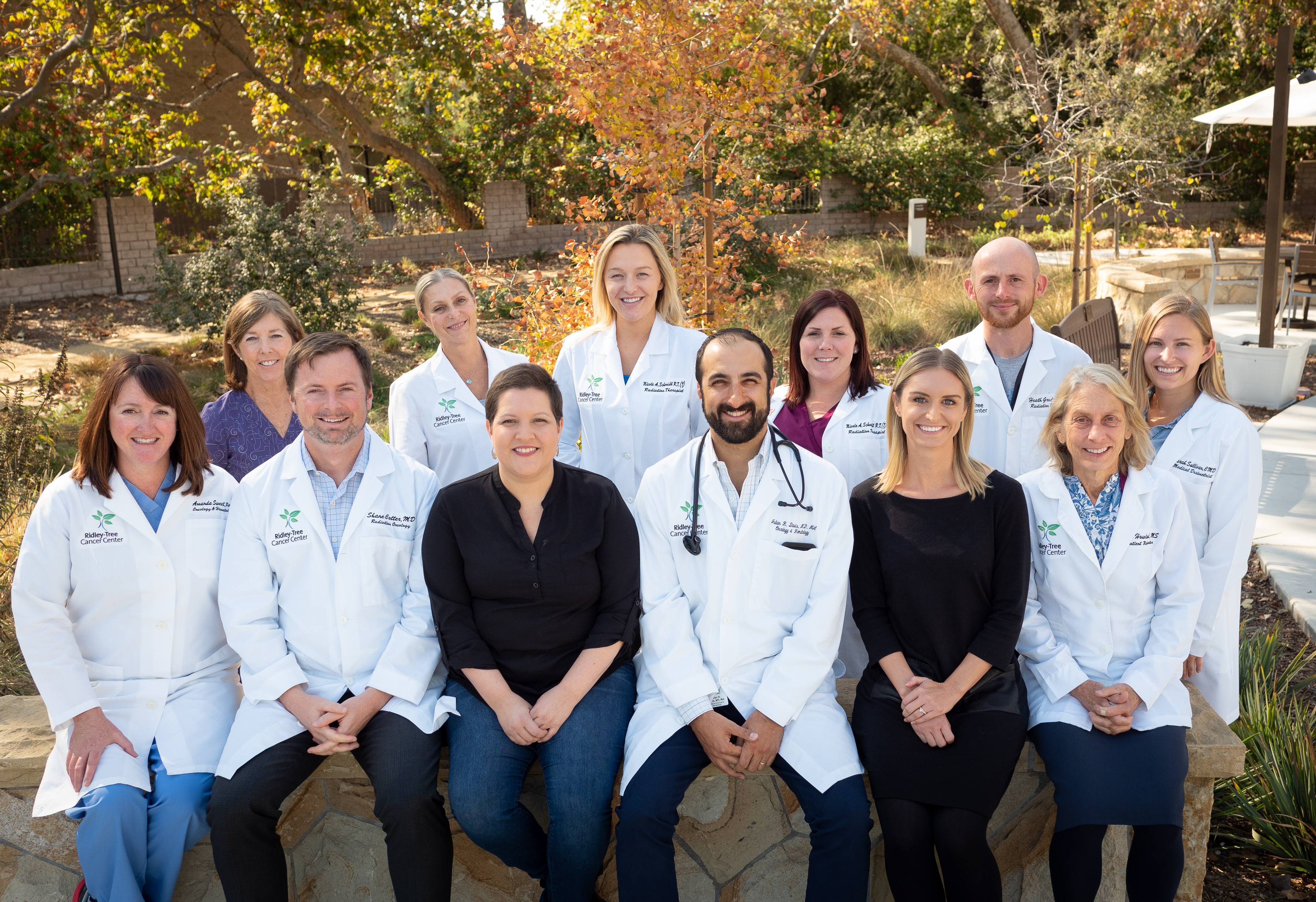A Community of Care
Whitney Lynd's Story
Whitney Lynd is one of those “six degrees of separation” stories of Santa Barbara, a phenomenon common to those born and raised here who constantly run into people they know. A daughter of restaurant owners, she attended local schools and then forged a career in hospitality. As a young girl, Whitney participated in the Cancer Foundation’s Walk/Run fundraiser every year. In her 20s, Whitney would often work catering events and observe the kind nature of Lady Leslie Ridley-Tree, never knowing she’d one day receive treatment at the facility built on her generosity. In the fall of 2018, at age 31, Whitney discovered a lump in her breast, the same day she worked a community breast cancer fundraising event. Her cancer journey would unfold in just this way, with local connections serendipitously crossing as she built her circle of care.
 Whitney and her care team
Whitney and her care team
When imaging and a subsequent biopsy confirmed breast
cancer, Whitney says she cried, then got busy about the work of protecting her health. “At first, everything just spirals, as quickly as you can ever imagine. The hardest part with cancer is not knowing what will happen and having to be comfortable with that,” she notes. Whitney gained quick access to a group of local breast cancer experts, beginning with breast surgeon Kim Grafton, MD. Because of the size and certain characteristics of the tumor, Dr. Grafton immediately referred Whitney to Ridley-Tree Cancer Center. There, she met with her medical oncology team and genetic counselor Hannah Andrews, MS, LCGC. The genetic tests revealed Whitney carried a germline BRCA1 mutation, which significantly increases a woman’s lifetime risk of developing breast cancer and other cancers. Whitney felt some relief in having an explanation for her cancer at such a young age. “It was genetic, I just got a bad hand. I am glad it’s me and not my sister or my cousins. I joke that I am taking one for the team this year,” she says. Whitney and her mom, Kacy
Whitney and her mom, Kacy
Dr. Grafton and Ridley-Tree oncologist
Julian Davis, MD knew
Whitney’s case would benefit from a multidisciplinary review at the weekly breast cancer case conference, a varied group of specialists who could examine the genetic data, imaging and pathology report to determine Whitney’s best course of treatment. The conference’s recommendation included lymph node surgery by Dr. Grafton first, then chemotherapy, followed by a mastectomy, then radiation therapy. Armed with the advice of the tumor board, Whitney felt confident and back in control when crafting her treatment plan. In addition to her mother, Kacy, Ridley-Tree patient navigator Sam Howland, MS, CBPN-IC became Whitney’s carecoordinator. Sam laid out her coming year, cheering her on to stay positive and keep going.“Sometimes I didn’t want to leave my bed, and Sam would tell me, ‘You can do it,’” shares Whitney.
As her bond with her Ridley-Tree team was growing, so was the number of community physicians who would lend their expertise to Whitney’s care. Fertility doctor René Allen, MD came on board to freeze her eggs, preserving her ability to have children in the future. When Dr. Grafton performed Whitney’s mastectomy, surgeon Wesley Schooler, MD joined the procedure to reconstruct her breast. Afterwards, a short but debilitating infection led to a stay at Cottage Hospital. Despite the setback, Whitney’s humor and spirit were unshakable. She took the challenge in stride and determined to progress and maintain her therapy schedule. When Whitney returned to Ridley-Tree to continue her treatment, a big team of clinical and support staff surrounded Whitney to guide and encourage her. She visited the Resource Library to educate herself on her condition, tackled insurance issues with support services case worker Sherry Massey and attended a support group for young adults with cancer to give herself an outlet for managing the challenges of work and home. As chemotherapy began, Whitney consulted with her oncology dietitian nutritionist Rebecca Colvin, MPH, RDN, CSO and together, they designed her diet to help manage gastrointestinal issues. Whitney’s humor remained intact even as her hair was disappearing. “This was the job I never applied for,” she jokes. “But I did feel losing my hair was a sign that the drug was working.” When Whitney’s course of radiation therapy started, she especially appreciated the kindness and special attention she received from each member of the Radiation Oncology Department, from her Radiation Oncologist Shane Cotter, MD, PhD to the technicians and nurses. “The radiation team ended up being a huge part of my treatment in a way I didn’t expect,” she says.
In the same way Whitney’s longtime friends and family span the city, so did the many players in her medical team. This combined force of people gave Whitney the best possible chance for a successful outcome from breast cancer. The emotional lift she received was so profound, it changed her goals for the future.“I want to do something that gives back more,” she explains. “I think the support here and the genuine feeling of people caring about you makes the process go better. The Ridley-Tree Cancer Center is the best place to take care of you.”
Santa Barbara Breast Care Alliance
Many members of Whitney’s care team are part of the accredited Santa Barbara Breast Care Alliance (SBBCA). This breast care center “without walls” offers patients a network of local specialists, including breast surgeons, reconstructive surgeons, medical and radiation oncologists, pathologists, radiologists, clinical researchers, genetic counselors, patient navigators, oncology dietitian nutritionists, social workers, physical therapists and lymphedema specialists. Its weekly multi-disciplinary breast cancer case-review conference is the centerpiece of the program. The collaboration of this highly-qualified team greatly exemplifies our medical community. The Alliance is dedicated to staying at the leading edge of breast medicine and to ensuring that all patients in our community receive the best care possible.
 Santa Barbara Breast Care Alliance
Santa Barbara Breast Care Alliance